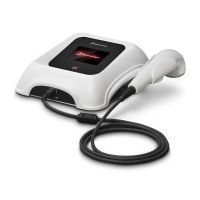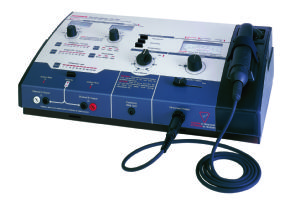 Written by Morgan Hopkins, DPT, CMTPT
Written by Morgan Hopkins, DPT, CMTPT
Ultrasound therapy is a non-invasive treatment that employs high-frequency sound waves to alleviate pain, reduce inflammation, and promote soft tissue healing. It can be highly effective with one recent study showing 85.4% of patients experiencing improvement in soft tissue inflammation, 83.3% in acute pain, and 64.6% in chronic pain. Based on these findings, ultrasound therapy can be a valuable addition to many therapy regimens.
Various types of ultrasound machines are available on the market, each with different features and capabilities. Choosing the right machine for your needs can be daunting, but it is important to understand the different options and features to make an informed decision. Factors to consider when choosing a machine include the type of therapy you need, the size and portability of the machine, and the cost. Additionally, it's important to consider the warranty and customer service provided by the manufacturer. It's crucial to consult a medical professional before buying any ultrasound machine to ensure it is suitable for your specific needs.
High-frequency sound waves are used in ultrasound therapy to penetrate deep into tissue and promote healing. A transducer is coated with gel, and sound waves are directed at the affected area. These waves produce various frequencies, which vibrate or heat the damaged tissue. Vibrations cause tiny bubbles in the surrounding fluid, increasing blood flow and oxygenation to the area and reducing inflammation. Heating also aids in the relief of pain and muscle spasms. The duration and frequency of treatment are determined by the condition and the patient's response.
 | Dynatron 125 Portable Ultrasound with Soundhead by Dynatronics View Product |
Portable ultrasound units for home use are smaller, handheld versions of the larger clinical machines typically used in medical settings. These units are more affordable and convenient for patients to use at home, but they typically have less power and versatility than clinical machines. They are designed for self-treatment and can treat various conditions such as muscle and joint pain, sprains, strains, and tendinitis. They are usually easy to use and come with detailed instructions. It is important to note that while these units can provide benefits and are becoming more popular, it is recommended to consult a healthcare professional before using them to ensure it is safe and appropriate for the individual's condition.
| Intelect TranSport Combo View Product |
High-end clinical ultrasound units are advanced medical devices that are used to treat a wide range of conditions. They feature multiple channels and applicators that allow for a high volume of patients to be treated. These units are typically used in hospitals and clinics, where trained medical professionals operate them. However, they can be taken on the road if needed for patient care. They are equipped with advanced technology and features that allow for more effective treatment of different conditions.
 | High Volt Electrical Muscle Stimulation and Therapeutic Ultrasound Combo - SynchroSonic US752 by Amrex View Product |
Combo units with E-stim are medical devices that combine two different therapies, ultrasound, and electrotherapy. These units allow for a greater range of treatment options by using the combination of both ultrasound and electrotherapy to target different conditions. These units are typically more expensive than single therapy units due to combining two different technologies in one device. They are used in clinics and hospitals by trained medical professionals and in various applications such as musculoskeletal, pain management, wound healing, physical therapy, and rehabilitation. They are the best option for those who want to provide their patients with the most versatile treatment and care.
For clinical use, high-end clinical ultrasound units with multiple channels and applicators are typically the best option, as they can handle a high volume of patients and a wide range of conditions. They are equipped with advanced technology and features that allow for more effective treatment of different conditions.
On the other hand, if you are looking for a unit for home use, smaller portable units may be a better option. These units are more affordable and are designed for easy use by the patient or a caregiver. They may not have as many features or channels as the clinical units, but they can still provide effective treatment for various conditions. However, it is important to keep in mind that these units may not be able to withstand the same level of use as clinical units, as they are not designed for a high volume of patients day after day.
The cost of an ultrasound unit can vary widely, depending on the unit type and its intended use, ranging from several hundred dollars to thousands of dollars.
When considering purchasing an ultrasound unit, it is important to consider your budget and the unit's intended use. It's also important to note that while a more expensive unit may have more features and capabilities, it may not necessarily be the best option for your specific needs. It's always a good idea to consult with a medical professional before making a purchase to ensure that you get the right device for your budget and requirements.
When choosing an ultrasound unit, it is important to consider the specific condition you are trying to treat. Most ultrasound units are effective at pain relief, but if you are dealing with a more serious condition such as scar tissue, poor circulation, serious injury, or arthritis, it may be worth prioritizing a unit with a 1 MHz applicator. These applicators are considered more powerful and are better suited to treating deeper and more complex conditions.
When choosing an ultrasound unit, portability is an important factor to consider. Some units are far more portable than others, with varying sizes, weights, and wired/wireless options. Portable units are smaller, lightweight, and can be easily carried around, making them ideal for home use or for therapists who need to travel to different locations to treat patients. They also often have battery-powered options, allowing for treatment sessions in places where an electrical outlets may not be available.
On the other hand, larger clinical units are typically more powerful and are equipped with multiple channels and applicators, but they are less portable and are typically used in fixed locations such as clinics and hospitals. Therefore, they may not be as convenient for patients or therapists who need to travel frequently.
When considering portability, it's important to consider how and where you plan to use the unit. A larger, more powerful unit may be a better option if you are using the unit primarily in a fixed location. If you need to be able to take the unit with you to different locations, a smaller, more portable unit may be a better fit.
The MHz of the ultrasound applicator makes a difference in how deep the treatment goes. Applicators with a higher frequency range (around 3-5 MHz) are typically used for superficial treatment such as skin conditions or superficial soft tissue injuries. They cannot penetrate as deep as lower-frequency applicators, but they can still provide effective treatment for alternate conditions.
Applicators with a lower frequency range (around 0.5-1 MHz) are used for deeper tissue treatment, such as muscle and joint injuries. These applicators can penetrate deeper into the tissue and are better suited to treating deeper and more complex conditions.
Yes, it is possible to use ultrasound therapy at home. Smaller portable units are designed for home use and can be operated by the patient or a caregiver.
Ultrasound therapy is generally considered safe for most people when used as directed. It is a non-invasive procedure that promotes healing and reduces pain using sound waves. It does not employ ionizing radiation, and the energy levels are significantly lower than those utilized in diagnostic ultrasound imaging.
However, there are some risks and precautions to consider, as with any medical procedure. For example, people with pacemakers or other electronic medical devices should avoid ultrasound therapy because sound waves can interfere with their operation.
Certain individuals should not use ultrasound therapy under some conditions. Contraindications for ultrasound therapy include the following.
Pregnancy: Ultrasound therapy should not be used on pregnant women, especially during the first trimester, as the sound waves may harm the developing fetus.
Metal Implants: People with metal implants, such as artificial joints, should avoid ultrasound therapy over the affected region as the sound waves can cause heating of the metal, which may lead to pain or damage to the surrounding tissue.
Active Infection: Ultrasound therapy should not be used on areas of the body that have an active infection, as sound waves may spread the infection.
Malignant Tissues: Ultrasound therapy should not be used on malignant tissues - as sound waves may promote the growth of cancer cells.
For decades, therapeutic ultrasound has been used to treat conditions such as muscle strains, inflammation, and pain. With so many therapeutic ultrasound devices on the market, it's critical to consider factors like intended use, budget, targeted condition, portability, and treatment depth.
Ultrasound therapy can help speed up recovery and relieve pain caused by injuries. It's a beneficial modality to consider when looking for a treatment option.
Thank you for reading this article. We hope you found it informative and educational. Stay tuned for more valuable content on our Caregiver University platform.
>> Shop Therapeutic Ultrasound <<
Morgan Hopkins is a licensed doctor of physical therapy and freelance medical writer. She practiced clinically in outpatient orthopedics for 8+ years specializing in intramuscular dry needling, dance medicine, and post-operative care. Morgan seeks to be a leader in the continued shift toward preventative healthcare, helping people optimize movement now so they can move for years to come. She is a firm believer in complementary therapies, holistic wellness, and functional fitness and is thrilled to be able to educate others through Rehabmart’s platform.